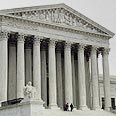
U.S. court divides commandments
Decisions on two cases - first in more than 20 years - thread needle; Jewish groups react
WASHINGTON - A divided U.S. Supreme Court ruled that putting framed copies of the Ten Commandments in county courthouses violated church-state separation, but it allowed a commandments monument in a larger display on a state Capitol grounds.
The two 5-4 rulings on the politically charged issue of displaying the Ten Commandments on government property came in a pair of cases regarded as the most important of the court term concerning constitutional separation of church and state.
In one decision, the high court ruled that Kentucky officials acted with a "predominantly religious purpose" when they posted framed copies of the Ten Commandments on the walls of courthouses in McCreary and Pulaski counties.
In the other decision, the high court upheld the large granite monument inscribed with the Ten Commandments on the Texas Capitol grounds as part of a display that included numerous other monuments and statutes.
Part of the distinction between the two rulings turned on the intent of government officials concerning the displays and whether they conveyed a mainly religious message.
A number of legal battles have taken place around the country in recent years over displays of the Ten Commandments on government property, dividing the public and producing conflicting rulings by U.S. appeals courts.
The Republican administration of President George W. Bush supported each of the latest displays. The Supreme Court last ruled on the issue in 1980 when it banned the posting of copies of the Ten Commandments in public school classrooms.
Justice Stephen Breyer, normally one of the court's more liberal members, provided a key swing vote in the two cases, joining the majority to strike down the Kentucky displays and then joining four of the court's conservatives to uphold the Texas monument.
Religious objectives
Breyer said the Texas case differed from the Kentucky one where the history of the courthouse displays demonstrated "the substantially religious objectives" of those who put them up and that it had this effect on those who viewed them.
The two rulings produced 10 separate opinions that totalled about 140 pages. Justice Clarence Thomas, who strongly supported the displays, said the inconsistency between the two decisions would only compound the confusion over what was permissible.
In the Kentucky ruling, Justice David Souter said for the majority that state officials were not following the neutrality and church-state separation demanded by the framers of the Constitution.
"This is no time to turn our back on a principle of neutrality that has served freedom and liberty," he said from the bench in summarising the ruling for the court majority.
He said the Kentucky displays were different from the marble frieze by the ceiling of the Supreme Court courtroom that depicts Moses with a tablet representing the Ten Commandments. That one included 17 other lawgivers, he said.
Justice Antonin Scalia issued a blistering dissent that was joined by Chief Justice William Rehnquist and Justices Thomas and Anthony Kennedy.
Scalia cited the role of religion in U.S. history. He said presidents still conclude the presidential oath with the words "so help me God" and that U.S. coins bear the motto, "In God we trust."
In the Texas case, Rehnquist said for the majority that the state has treated the monuments on the capitol grounds as representing several strands in the state's political and legal history.
Including the Ten Commandments monument has a dual significance, partaking of both religion and government, he said, adding that it stood among 21 historical markers and 17 monuments surrounding the Texas State Capitol.
Reaction to the ruling was split.
"This is a mixed verdict, but on balance it's a win for separation of religion and government," said the Rev. Barry Lynn of the group Americans United for Separation of Church and State.
Supporters of the displays emphasized the Texas ruling.
"It is very encouraging that the Supreme Court ... moved to protect thousands of monuments now in place across America," said Jay Sekulow of the American Center for Law and Justice.










